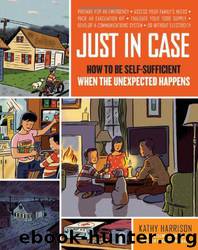Just in Case: How to Be Self-Sufficient When the Unexpected Happens by Kathy Harrison & Alison Kolesar

Author:Kathy Harrison & Alison Kolesar
Language: eng
Format: mobi, epub
Tags: Emergency Management, Technology & Engineering, Social Science, Reference, Disasters & Disaster Relief, General, Crafts & Hobbies, Security, House & Home, Do-It-Yourself
ISBN: 9781603420358
Publisher: Storey Publishing
Published: 2008-07-23T00:00:00+00:00
IF YOU LIVE IN AN AREA AT RISK FOR WILDFIRES:
• Make sure the entrance to your home has appropriate, easy-to-see signage so emergency vehicles can find you if necessary.
• Keep your lawn trimmed. Rake and dispose of leaves, lawn trimmings, and brush piles. Do not allow dead limbs to accumulate.
• Stack firewood well away from your home.
• Thin trees and brush within thirty feet of your home. Beyond that, remove dead wood and low tree branches.
• Plant fire-resistant vegetation. Check with a local nursery for appropriate choices. In general, evergreens are more likely to burn than hardwood trees.
• Ensure that water sources such as swimming pools, ponds, and fire hydrants are accessible to firefighters.
• If you’re building, consider using brick, stone, and metal, which are noncombustible.
• Cover all exterior vents and eaves with J^-inch metal mesh screens, which can keep sparks out.
• Consider installing fireproof shutters to protect your windows from radiant heat.
• If you have attic or ground vents, obtain covers for them. You can purchase premade covers or you can cut them from plywood.
• Be particularly careful of storing flammable items. Keep them in appropriate containers in a shed or outbuilding at least thirty feet away from your home and other wooden structures such as fences.
IF YOUR HOME IS IN THE PATH OF A WILDFIRE, TAKE THE FOLLOWING STEPS, IF TIME PERMITS:
Fire travels fast and can be unpredictable. Err always on the side of caution.
• Shut off gas at the meter. (Note that you will need to call a qualified technician to have it turned back on later.)
• Seal attic and ground vents with covers.
• Turn off propane tanks. If you have a gas grill, position it well away from your residence, preferably in a distant shed.
• Connect your garden hose and lawn sprinklers. Turn them on and position them to wet your roof and fuel tanks.
• Wet shrubs near your home or cut them away.
• Open the fireplace damper but close the screens. Close windows and doors. Take down any combustible drapes.
• Move furniture to the center of rooms, away from windows. Close all interior doors and vents. Your object is to slow the spread of fire as much as possible.
• Pack your evacuation kits in the car, along with any other essentials. Corral your pets so that you can grab them on a moment’s notice. Park your car facing the street, with the garage door open, and keep the keys in your pocket.
• Heed calls for evacuation. Drive away from the fire, keeping your eye on changes in wind speed or direction.
If you find yourself trapped by a wildfire, a pool, pond, stream, or any large body of water will be the safest location. Submerge yourself as much as possible in the water. Place a wet cloth over your face to protect your nose, mouth, and eyes from smoke.
THUNDERSTORMS
THUNDERSTORMS MAY NOT have the drama of hurricanes or tornadoes, but they can still be very dangerous. They can reduce visibility, making driving hazardous. They produce lightning, which
Download
Just in Case: How to Be Self-Sufficient When the Unexpected Happens by Kathy Harrison & Alison Kolesar.epub
This site does not store any files on its server. We only index and link to content provided by other sites. Please contact the content providers to delete copyright contents if any and email us, we'll remove relevant links or contents immediately.
Audition by Ryu Murakami(4093)
The Body: A Guide for Occupants by Bill Bryson(3791)
Adulting by Kelly Williams Brown(3663)
Housekeeping by Marilynne Robinson(3397)
Zero Waste Home by Bea Johnson(3286)
Be in a Treehouse by Pete Nelson(3207)
Seriously... I'm Kidding by Ellen DeGeneres(3098)
Better Homes and Gardens New Cookbook by Better Homes & Gardens(2950)
Barkskins by Annie Proulx(2877)
The Healing Self by Deepak Chopra(2792)
Hedgerow by John Wright(2772)
The Life-Changing Magic Of Tidying Up- The Japanese Art Of Decluttering And Organizing (v5.0) by Marie Kondo(2742)
Spark Joy by Marie Kondo(2671)
The Genius of Japanese Carpentry by Azby Brown(2602)
The Cellar by Natasha Preston(2592)
Work Clean by Dan Charnas(2557)
120 Days of Sodom by Marquis de Sade(2428)
The Book of Numbers by Peter Bentley(2400)
A Monk's Guide to a Clean House and Mind by Shoukei Matsumoto(2400)
